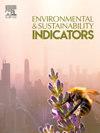梯级微湿地工程通过生境异质性增强底栖无脊椎动物多样性:对基于自然的微湿地管理的启示
IF 5.4
Q1 ENVIRONMENTAL SCIENCES
引用次数: 0
摘要
微湿地作为一种理想的基于自然的解决方案,为各种动植物提供了必要的栖息地,在维持生态系统健康方面发挥着重要作用。然而,微湿地工程的生境异质性对生物多样性的影响机制尚不明确。本研究通过对重庆某微湿地系统的综合采样,鉴定出47种大型底栖动物,揭示了梯级微湿地的物种多样性明显高于非梯级微湿地。这种增强的多样性主要是由物种更替而不是巢性驱动的。研究进一步表明,水文条件、土壤特征和空间因子对微湿地生态系统β多样性有显著影响。Zeta多样性分析表明,决定物种分布的是确定性过程,而不是随机过程。随着环境距离的增加,特别是在高zeta阶,物种多样性降低。这些发现强调了生境异质性在促进生物多样性和指导基于自然的微湿地保护与管理中的重要性。本文章由计算机程序翻译,如有差异,请以英文原文为准。
Cascade micro-wetland engineering enhances benthic invertebrate diversity through habitat heterogeneity: Implications for nature-based micro-wetlands management
Micro-wetlands, as an ideal nature-based solutions, provide essential habitats for various plants and animals playing critical roles in maintaining ecosystem health. However, the influence mechanism of habitat heterogeneity of micro-wetlands engineering on biodiversity remain unexplored. Here, through comprehensive sampling in a micro-wetlands system of Chongqing, the study identified 47 species of macro-benthic animals, revealing that cascade micro-wetlands exhibit significantly higher species diversity than non-cascade ones. This enhanced diversity is driven primarily by species turnover rather than nestedness. The study further shows that hydrological conditions, soil characteristics, and spatial factors significantly influence beta diversity in micro-wetland ecosystems. Zeta diversity analysis suggests that deterministic processes, rather than stochastic ones, govern species distribution. As environmental distance increases, particularly at higher zeta orders, the diversity of species decreases. These findings underscore the importance of habitat heterogeneity in promoting biodiversity and guiding nature-based micro-wetland conservation and management.
求助全文
通过发布文献求助,成功后即可免费获取论文全文。
去求助
来源期刊

Environmental and Sustainability Indicators
Environmental Science-Environmental Science (miscellaneous)
CiteScore
7.80
自引率
2.30%
发文量
49
审稿时长
57 days
 求助内容:
求助内容: 应助结果提醒方式:
应助结果提醒方式:


